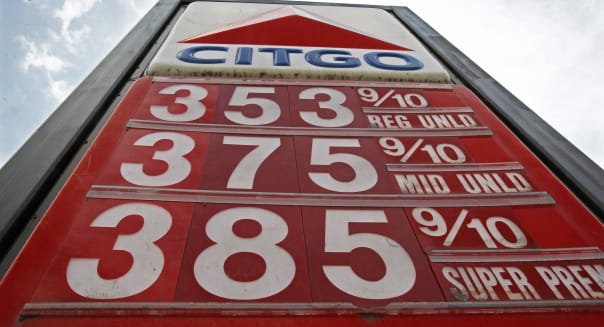DELAFIELD, Wis. (Stockpickr) -- Professional traders running mutual funds and hedge funds don't just look at a stock's price moves; they also track big changes in volume activity. Often when above-average volume moves into an equity, it precedes a large spike in volatility.
Must Read: Warren Buffett's Top 10 Dividend Stocks
Major moves in volume can signal unusual activity, such as insider buying or selling -- or buying or selling by "superinvestors."
Unusual volume can also be a major signal that hedge funds and momentum traders are piling into a stock ahead of a catalyst. These types of traders like to get in well before a large spike, so it's always a smart move to monitor unusual volume. That said, remember to combine trend and price action with unusual volume. Put them all together to help you decipher the next big trend for any stock.
With that in mind, let's take a look at several stocks rising on unusual volume recently.
Must Read: 10 Stocks Carl Icahn Loves in 2014
comScore
comScore (SCOR) provides a range of digital media analytics solutions in the U.S., Europe, Canada and others. This stock closed up 3% to $39.38 in Monday's trading session.
Monday's Volume: 429,000
Three-Month Average Volume: 195,363
Volume % Change: 142%
From a technical perspective, SCOR jumped higher here right off its 50-day moving average of $37.86 with above-average volume. This spike to the upside on Monday is quickly pushing shares of SCOR within range of triggering a major breakout trade. That trade will hit if SCOR manages to take out some key near-term overhead resistance levels at $39.70 to its 52-week high of $39.78 with high volume.
Traders should now look for long-biased trades in SCOR as long as it's trending above its 50-day at $37.86 or above more near-term support levels at $37 or $36 and then once it sustains a move or close above those breakout levels with volume that hits near or above 195,363 shares. If that breakout hits soon, then SCOR will set up to enter new 52-week-high territory, which is bullish technical price action. Some possible upside targets off that breakout are $45 to $50.
Must Read: 10 Stocks George Soros Is Buying
Williams Partners
Williams Partners (WPZ), an energy infrastructure company, focuses on connecting North America's hydrocarbon resource plays to growing markets for natural gas and natural gas liquids. This stock closed up 3.5% at $51.75 in Monday's trading session.
Monday's Volume: 3.42 million
Three-Month Average Volume: 972,045
Volume % Change: 269%
From a technical perspective, WPZ jumped notably higher here back above its 200-day moving average of $50.73 with strong upside volume flows. This trend to the upside on Monday is quickly pushing shares of WPZ within range of triggering a near-term breakout trade. That trade will hit if WPZ manages to take out its 50-day moving average of $52.26 and then once it clears more key near-term overhead resistance at $52.90 with high volume.
Traders should now look for long-biased trades in WPZ as long as it's trending above Monday's intraday low of $50 and then once it sustains a move or close above those breakout levels with volume that hits near or above 972,045 shares. If that breakout hits soon, then WPZ will set up to re-test or possibly take out its next major overhead resistance levels at $55.28 to $56.30, or even its 52-week high at $57.29.
Must Read: 5 Stocks Under $10 Set to Soar
Access Midstream Partners
Access Midstream Partners (ACMP) owns, operates, develops and acquires natural gas, natural gas liquids and oil gathering systems, and other midstream energy assets in the U.S. This stock closed up 3.1% to $62.76 in Monday's trading session.
Monday's Volume: 2.51 million
Three-Month Average Volume: 434,394
Volume % Change: 427%
From a technical perspective, ACMP jumped higher here back above its 50-day moving average of $62.41 with heavy upside volume flows. This move also pushed shares of ACMP into breakout territory, since the stock took out some near-term overhead resistance at $62.08 to just under $63. Market players should now look for a continuation move to the upside in the short-term if ACMP manages to take out Monday's intraday high of $63.64 with high volume.
Traders should now look for long-biased trades in ACMP as long as it's trending above Monday's intraday low of $60.98 or above its 200-day at $59.40 and then once it sustains a move or close above $63.64 with volume that hits near or above 434,394 shares. If that move begins soon, then ACMP will set up to re-test or possibly take out its next major overhead resistance levels at $65.55 to $65.90, or even its 52-week high at $66.71. Any high-volume move above those levels will then give ACMP a chance to make a run at $70.
Must Read: 7 Stocks Warren Buffett Is Selling in 2014
GSI Group
GSI Group (GSIG), together with its subsidiaries, designs, develops, manufactures and sells precision photonic and motion control components and subsystems to original equipment manufacturers in the medical, industrial, electronics and scientific markets. This stock closed up 3.8% at $12.32 in Monday's trading session.
Monday's Volume: 141,000
Three-Month Average Volume: 69,503
Volume % Change: 110%
From a technical perspective, GSIG spiked notably higher here back above both its 50-day moving average of $12.07 and its 200-day moving average of $12.15 with above-average volume. This trend to the upside on Monday also pushed shares of GSIG into breakout territory, since the stock took out some near-term overhead resistance levels at $11.91 to $12.05. Market players should now look for a continuation move to the upside in the short-term if GSIG manages to take out Monday's intraday high of $12.40 to some more near-term overhead resistance just above $12.60 with high volume.
Traders should now look for long-biased trades in GSIG as long as it's trending above Monday's intraday low of $11.80 or above $11.60 and then once it sustains a move or close above $12.40 to around $12.60 with volume that this near or above 69,503 shares. If that move gets set off soon, the GSIG will set up to re-test or possibly take out its next major overhead resistance levels at $13.19 to its 52-week high at $13.71. Any high-volume move above those levels will then give GSIG a chance to tag $15.
Must Read: 5 Stocks Insiders Love Right Now
Level 3 Communications
Level 3 Communications (LVLT), together with its subsidiaries, operates as a facilities-based provider of a range of integrated communications services primarily in North America, Latin America, Europe, the Middle East and Africa. This stock closed up 2.9% at $43.46 in Monday's trading session.
Monday's Volume: 3.83 million
Three-Month Average Volume: 2.14 million
Volume % Change: 89%
From a technical perspective, LVLT jumped higher here right above its 200-day moving average of $41.17 with above-average volume. This stock has been uptrending over the last few weeks, with shares moving higher from its low of $37.61 to its intraday high of $43.60. During that uptrend, shares of LVLT have been consistently making higher lows and higher highs, which is bullish technical price action. Market players should now look for a continuation move to the upside in the short-term if LVLT manages to take out its 50-day moving average of $43.56 to some more near-term overhead resistance at $44 with high volume.
Traders should now look for long-biased trades in LVLT as long as it's trending above its 200-day at $41.17 and then once it sustains a move or close above $43.56 to $44 with volume that's near or above 2.14 million shares. If that move materializes soon, then LVLT will set up to re-test or possibly take out its next major overhead resistance levels at $46.20 to $48.21, or even its 52-week high at $49.22.
Must Read: 10 Stocks Billionaire John Paulson Loves in 2014
To see more stocks rising on unusual volume, check out the Stocks Rising on Unusual Volume portfolio on Stockpickr.
-- Written by Roberto Pedone in Delafield, Wis.
RELATED LINKS:
>>5 Rocket Stocks to Buy for November Gains
>>5 Stocks Poised for Breakouts
>>Book Double the Gains With These 5 Shareholder Yield Champs
Follow Stockpickr on Twitter and become a fan on Facebook.
At the time of publication, author had no positions in stocks mentioned.
Roberto Pedone, based out of Delafield, Wis., is an independent trader who focuses on technical analysis for small- and large-cap stocks, options, futures, commodities and currencies. Roberto studied international business at the Milwaukee School of Engineering, and he spent a year overseas studying business in Lubeck, Germany. His work has appeared on financial outlets including
CNBC.com and Forbes.com. You can follow Pedone on Twitter at www.twitter.com/zerosum24 or @zerosum24.



 ) announced third quarter revenues that fell 14% to $5.89 billion from $6.8 billion in 2012′s Q3. The company attributed the loss to the weak yen/USD exchange rate. Net earnings for the company came in at $702 million, or $1.50 per share, which was down from $1 billion, or $2.16 per share, a year ago. Not including one-time items, AFL’s EPS came in at $1.47, which missed analysts’ estimates of $1.48. Revenues barely missed analyst views of $5.9 billion. The company announced its 2014 share buyback program being in the range of $800 million to $1 billion.
) announced third quarter revenues that fell 14% to $5.89 billion from $6.8 billion in 2012′s Q3. The company attributed the loss to the weak yen/USD exchange rate. Net earnings for the company came in at $702 million, or $1.50 per share, which was down from $1 billion, or $2.16 per share, a year ago. Not including one-time items, AFL’s EPS came in at $1.47, which missed analysts’ estimates of $1.48. Revenues barely missed analyst views of $5.9 billion. The company announced its 2014 share buyback program being in the range of $800 million to $1 billion. Today, gold stocks look incredibly cheap. The average gold company in the Market Vectors Gold Miners Fund trades at just 11 times earnings. Plus, on a technical level, it looks as if gold prices have finally found a bottom. We could see a big bounce here. But I still see more pain ahead. According to Bloomberg, gold producers spent nearly $200 billion on acquisitions over the past 10 years. Many of these large acquisitions – like the $7.1 billion Kinross Gold paid for Red Back Mining or the $7.3 billion Barrick Gold paid for Equinox Minerals – took place in just the past 24 months. As my colleague Matt Badiali has pointed out, many of these projects will have to be written down. This trend has just begun. Bloomberg says that gold producers wrote down $17 billion in projects in just the past 18 months. With the price of gold trading at the same price as production costs, we could see this number grow fivefold in the next 18 months. I'm sure many names in the sector will be reporting losses at least over the next few quarters. And even with prices down this much, I don't see this risk factored in to most gold stocks. My advice is to continue to stay clear of the gold sector. You may see a few bounces – even a violent rally, like my colleague Jeff Clark is predicting. But based on the headwinds facing gold stocks – and the billions in write-downs that have yet to be announced – you are better off looking elsewhere to find cheap stocks for the long term. Good investing, Frank Curzio
Today, gold stocks look incredibly cheap. The average gold company in the Market Vectors Gold Miners Fund trades at just 11 times earnings. Plus, on a technical level, it looks as if gold prices have finally found a bottom. We could see a big bounce here. But I still see more pain ahead. According to Bloomberg, gold producers spent nearly $200 billion on acquisitions over the past 10 years. Many of these large acquisitions – like the $7.1 billion Kinross Gold paid for Red Back Mining or the $7.3 billion Barrick Gold paid for Equinox Minerals – took place in just the past 24 months. As my colleague Matt Badiali has pointed out, many of these projects will have to be written down. This trend has just begun. Bloomberg says that gold producers wrote down $17 billion in projects in just the past 18 months. With the price of gold trading at the same price as production costs, we could see this number grow fivefold in the next 18 months. I'm sure many names in the sector will be reporting losses at least over the next few quarters. And even with prices down this much, I don't see this risk factored in to most gold stocks. My advice is to continue to stay clear of the gold sector. You may see a few bounces – even a violent rally, like my colleague Jeff Clark is predicting. But based on the headwinds facing gold stocks – and the billions in write-downs that have yet to be announced – you are better off looking elsewhere to find cheap stocks for the long term. Good investing, Frank Curzio  Related BZSUM Dow Dips Over 200 Points; Vistaprint Shares Surge On Strong Results Markets Tumble; Kellogg Lowers Full-Year Forecast
Related BZSUM Dow Dips Over 200 Points; Vistaprint Shares Surge On Strong Results Markets Tumble; Kellogg Lowers Full-Year Forecast  The 2014 Chevy Camaro is one the cars included in the latest GM recall NEW YORK (CNNMoney) General Motors announced a new recall of 512,000 Camaros, saying a flaw can switch the popular sports car off while it's being driven.
The 2014 Chevy Camaro is one the cars included in the latest GM recall NEW YORK (CNNMoney) General Motors announced a new recall of 512,000 Camaros, saying a flaw can switch the popular sports car off while it's being driven.  The price tag for corporate negligence
The price tag for corporate negligence 
 Popular Posts: Hottest Energy Stocks Now – HK QEP CLMT SDRL13 “Triple A” Stocks to Buy7 Biotechnology Stocks to Buy Now Recent Posts: Hottest Healthcare Stocks Now – CAH PDLI SHPG FRX Hottest Technology Stocks Now – CYOU HPQ NCR MSFT Biggest Movers in Financial Stocks Now – RDN AIG MTG MFG View All Posts
Popular Posts: Hottest Energy Stocks Now – HK QEP CLMT SDRL13 “Triple A” Stocks to Buy7 Biotechnology Stocks to Buy Now Recent Posts: Hottest Healthcare Stocks Now – CAH PDLI SHPG FRX Hottest Technology Stocks Now – CYOU HPQ NCR MSFT Biggest Movers in Financial Stocks Now – RDN AIG MTG MFG View All Posts 

 Toby Talbot/AP Gas is one of the most substantial household expenses for many families. I know it's a pretty big expense for mine. However, throughout the past couple of years, I've been trying to live a more frugal life. That involves looking for ways to pay less. Today, I'm going to share some secrets I've found that can save you a pretty penny at the pump. Secret No. 1: Look for local deals. When we look for local deals, we often think about coupon clipping for a few bucks saved at the local grocery store. However, that's not the only place you can save money locally. For instance, in my area, and to the best of my knowledge, in all of Oregon, shopping at Safeway (SWY) can save you money on gas. They have a rewards program and a partnership with Chevron which allows me to save up to $1 a gallon when I fill up. Do a little research online to see if there are any loyalty based gas rewards programs in your area. Secret No. 2: Use gas station credit cards. I know how annoying it can be to be asked, "Would you like to sign up for our credit card?" at the pump, but it's important to remember that doing so could save you a ton of money. The general reluctance to sign up stems from our fear that credit cards will lead us to overwhelming debt. That only happens if you let it. Credit cards also have the potential to save you a ton of money, if used correctly. Most gas station credit cards give you 10 percent off at the pump as well as rewards points when you use the card. If you do the math, you generally earn 10 to 12 percent savings when you use gas station cards. The key is not paying interest on your purchases. After all, how great can 12 percent really be if you're paying 20 percent to get it? The good news is avoiding interest really isn't all that hard. To avoid paying interest on your gas rewards credit card, simply pay your card off every time you fill up. The truth is credit cards have grace periods. If you pay your balance in full within the grace period, you won't be charged interest. By paying your card off the day you fill up, you'll be sure to make it within your grace period, meaning you won't have to pay for your rewards. Secret No. 3: Use your smartphone. We use our phones for everything else these days; why not use them to save money on gas? Some apps directly help to save money at the pump and some help in round about ways if you think outside the box. Here are a few examples. iGasUp: This is one of those apps that directly helps you to save money at the pump. Using this app, you can find the ten cheapest gas stations closest to your current location. Choose the station you want to go to and it will even give you directions on how to get there. The most amazing part to me is how accurate it is. It gets its pricing data through real time credit card transactions. Google Maps: One of the easiest ways to spend a ton of money on gas unnecessarily is to get lost. Making sure this app is on your phone will help ensure that you don't get lost, wasting gas in the process. Carticipate: If you're a social extrovert like me, you'll love Carticipate. One of the best ways to save money on gas is to carpool. Carticipate is an awesome app that helps bring carpoolers together. Not only will it save you money on gas, it can help you meet some pretty cool people. Gas is expensive, we all know that. However, these simple tips can save you quite a bit over the course of a year. By my calculations, following the secrets above, I save between $40 and $60 a month on gas, depending on how much I drive that much. That means these three simple steps save me $480 a year at the very minimum. I hope they do the same for you.
Toby Talbot/AP Gas is one of the most substantial household expenses for many families. I know it's a pretty big expense for mine. However, throughout the past couple of years, I've been trying to live a more frugal life. That involves looking for ways to pay less. Today, I'm going to share some secrets I've found that can save you a pretty penny at the pump. Secret No. 1: Look for local deals. When we look for local deals, we often think about coupon clipping for a few bucks saved at the local grocery store. However, that's not the only place you can save money locally. For instance, in my area, and to the best of my knowledge, in all of Oregon, shopping at Safeway (SWY) can save you money on gas. They have a rewards program and a partnership with Chevron which allows me to save up to $1 a gallon when I fill up. Do a little research online to see if there are any loyalty based gas rewards programs in your area. Secret No. 2: Use gas station credit cards. I know how annoying it can be to be asked, "Would you like to sign up for our credit card?" at the pump, but it's important to remember that doing so could save you a ton of money. The general reluctance to sign up stems from our fear that credit cards will lead us to overwhelming debt. That only happens if you let it. Credit cards also have the potential to save you a ton of money, if used correctly. Most gas station credit cards give you 10 percent off at the pump as well as rewards points when you use the card. If you do the math, you generally earn 10 to 12 percent savings when you use gas station cards. The key is not paying interest on your purchases. After all, how great can 12 percent really be if you're paying 20 percent to get it? The good news is avoiding interest really isn't all that hard. To avoid paying interest on your gas rewards credit card, simply pay your card off every time you fill up. The truth is credit cards have grace periods. If you pay your balance in full within the grace period, you won't be charged interest. By paying your card off the day you fill up, you'll be sure to make it within your grace period, meaning you won't have to pay for your rewards. Secret No. 3: Use your smartphone. We use our phones for everything else these days; why not use them to save money on gas? Some apps directly help to save money at the pump and some help in round about ways if you think outside the box. Here are a few examples. iGasUp: This is one of those apps that directly helps you to save money at the pump. Using this app, you can find the ten cheapest gas stations closest to your current location. Choose the station you want to go to and it will even give you directions on how to get there. The most amazing part to me is how accurate it is. It gets its pricing data through real time credit card transactions. Google Maps: One of the easiest ways to spend a ton of money on gas unnecessarily is to get lost. Making sure this app is on your phone will help ensure that you don't get lost, wasting gas in the process. Carticipate: If you're a social extrovert like me, you'll love Carticipate. One of the best ways to save money on gas is to carpool. Carticipate is an awesome app that helps bring carpoolers together. Not only will it save you money on gas, it can help you meet some pretty cool people. Gas is expensive, we all know that. However, these simple tips can save you quite a bit over the course of a year. By my calculations, following the secrets above, I save between $40 and $60 a month on gas, depending on how much I drive that much. That means these three simple steps save me $480 a year at the very minimum. I hope they do the same for you.